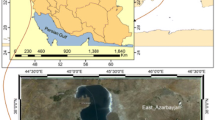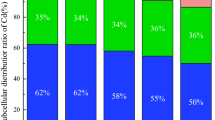Abstract
Crops, particularly in the Northeast region of Mexico, have to cope with increasing soil salinization due to irrigation. Chloride (Cl−) concentration has been strongly related to enhance cadmium (Cd) uptake by plants due to increased solubility in the soil solution. The effect of irrigation with slightly saline water from a local well was evaluated in this work on the accumulation and translocation of Cd in Swiss chard (Beta vulgaris L.) grown in soil historically amended with stabilized sewage sludge under a regime of phosphorus and zinc fertilization. A factorial pot experiment was conducted with two phosphate fertilizer levels (PF, 0 and 80 kg ha−1 dry soil, respectively), two Zn levels (0 and 7 kg ha−1 dry soil), and two sources of water for irrigation deionized water (DW) and slightly saline well water (WW) from an agricultural site. Additionally, a human risk assessment for Cd ingestion from plants was assessed. Results showed that Cl− salinity in the WW effectively mobilized soil Cd and increased its phytoavailability. A higher level of Cd was found in roots (46.41 mg kg−1) compared to shoots (10.75 mg kg−1). Although the total content of Cd in the edible parts of the Swiss chard irrigated with WW exceeded permissible recommended consumption limit, bioavailable cadmium in the aboveground parts of the plant in relation to the total cadmium content was in the range from 8 to 32 %. Therefore, human health risks might be overestimated when the total concentration is taken into account.

Similar content being viewed by others
References
Adams ML, Zhao FJ, McGrath SP, Nicholson FA, Chambers BJ (2004) Predicting cadmium concentrations in wheat and barley grain using soil properties. J Environ Qual 33:532–541
Al-Faiyz YS, El-Garawany MM, Assubaie FN, Al-Eed MA (2007) Impact of phosphate fertilizer on cadmium accumulation in soil and vegetable crops. Bull Environ Contam Toxicol 78:358–362
Anju M, Banerjee DK (2011) Associations of cadmium, zinc, and lead in soils from a lead and zinc mining area as studied by single and sequential extractions. Environ Monit Assess 176:67–85
Chen Y, Li X, Shen Z (2004) Leaching and uptake of heavy metals by ten different species of plants during an EDTA-assisted phytoextraction process. Chemosphere 57:187–196
Chen F, Dong J, Wang F, Wu F, Zhang G, Li G, Chen Z, Chen J, Wei K (2007) Identification of barley genotypes with low grain Cd accumulation and its interaction with four microelements. Chemosphere 67:2082–2088
Codex Alimentarius Commission, Joint FAO/WHO Food Standards Programme Codex Alimentarius Commission, Report of the Twenty-eighth Session, FAO, Rome, (2006) ALINORM 05/28/41
Dar SR, Thomas T, Dagar JC, Lal K, Mir AH, Kumar A, Mir H, Bakshi MR, Mehboob S, Singh D (2012) Zinc and cadmium availability as affected by zinc fertilization and saline water irrigation in wheat (Triticum aestivum L.) grown on cadmium polluted soil. Afr J Agric Res 7:4996–5004
Datta SP, Young SD (2005) Predicting metal uptake and risk to the human food chain from leaf vegetables grown on soils amended by long-term application of sewage sludge. Water Air Soil Pollut 163:119–136
Duncan RR, Carrow RN, Huck M (2000) Understanding water quality and guideline to management. USGA Green Section, Record. September-October:14–24
Elless MP, Blaylock MJ, Huang JW, Gussman CD (2000) Plants as a natural source of concentrated mineral nutritional supplements. Food Chem 71:181–188
EPA/540/1–89/002 (1989) US EPA risk assessment guidance for superfund, human health evaluation manual part A, interim final, vol. I. 7 United States Environmental Protection Agency, Washington (DC), USA
Feng MH, Shan XQ, Zhang S, Wen B. (2005). A comparison of the rhizosphere-based method with DTPA, EDTA, CaCl2, and NaNO3 extraction methods for prediction of bioavailability of metals in soil to barley. Environ Poll 137:231–240
Grant CA (2011) Phosphate effects on Cd accumulation in crops and soils. Pedologist 54:143–155
Grant CA, Bailey LD (1997) Effects of phosphorus and zinc fertilizer management on cadmium accumulation in flaxseed. J Sci Food Agric 73:307–314
Grant CA, Bailey LD (1998) Nitrogen, phosphorus and zinc management effects on grain yield and cadmium concentration in two cultivars of durum wheat. Can J Plant Sci 78:63–70
Hart JJ, Welch RM, Norvell WA, Kochian LV (2002) Transport interactions between cadmium and zinc in roots of bread and durum wheat seedlings. Physiol Plant 116:73–78
Horiguchi H, Oguma E, Sasaki S, Miyamoto K, Ikeda Y, Machida M, Kayama F (2004) Dietary exposure to cadmium at close to the current provisional tolerable weekly intake does not affect renal function among female Japanese farmers. Environ Res 95:20–31
Intawongse M, Dean JR (2008) Use of the physiologically-based extraction test to assess the oral bioaccessibility of metals in vegetable plants grown in contaminated soil. Environ Pollut 152(1):60–72
Intawongse M, Sriraksa S, Dean JR, Kongchana P (2012) Estimation of bioaccessibility of heavy metals in oysters using the physiologically based extraction test. Instrum Sci Technol 40:372–383
Järup L (2003) Hazards of heavy metal contamination. Br Med Bull 68:167–182
Jiao Y, Grant CA, Bailey LD (2004) Effects of phosphorus and zinc fertilizer on cadmium uptake and distribution in flax and durum wheat. J Sci Food Agric 84:777–785
Kirkham MB (2006) Cadmium in plants on polluted soils: effects of soil factors, hyperaccumulation, and amendments. Geoderma 137:19–32
Lisar SYS, Motafakkerazad R, Hossain MM, Rahman IMM (2012) Water stress in plants: causes, effects and responses, Water Stress, Prof. Ismail Md. Mofizur Rahman (Ed.), ISBN: 978-953-307-963-9, InTech, Available from: http://www.intechopen.com/books/water-stress/water-stress-inplants-causes-effects-and-responses
López-Chuken UJ, Young SD (2005) Plant screening of halophyte species for cadmium phytoremediation. Z Naturforsch C 60:236–243
López-Chuken UJ, Young SD, Sanchez-Gonzalez MN (2010) The use of chloro-complexation to enhance cadmium uptake by Zea mays and Brassica juncea: testing a free ion activity model and implications for phytoremediation. Int J Phytorem 12(7):680–696
Mapanda F, Mangwayana EN, Nyamangara J, Giller KE (2007) Uptake of heavy metals by vegetables irrigated using wastewater and the subsequent risks in Harare, Zimbabwe. Phys Chem Earth 32:1399–1405
Mattina MJI, Lannucci-Berger W, Musante C, White JC (2003) Concurrent plant uptake of heavy metals and persistent organic pollutants from soil. Environ Pollut 124:375–378
Menzies WN, Donn JM, Kopittke MP (2007) Evaluation of extractants for estimation of the phytoavailable trace metals in soil. Environ Pollut 145:121–130
Miller JN, Miller JC (2005) Statistics and chemometrics for analytical chemistry, 5th ed. Pearson/Prentice-Hall, Harlow England
Moustakas NK, Akoumianaki-Ioannidou A, Barouchas PE (2011) The effects of cadmium and zinc interactions on the concentration of cadmium and zinc in pot marigold (Calendula officinalis L.). Aust J Crop Sci 5:277–282
Mwazi FN, Amoonga S, Mubiana FS (2010) Evaluation of the effects of salinity on spinach (Beta vulgaris var. cicla) grown in a hydroponic system along the coast of Namibia. Agricola 20:14–17
NMX-AA-073-SCFI-2001 (2001) Water Analysis. Determination of chlorides in natural waters, drinking water, effluents and treated wastewaters
NOM-147-SEMARNAT/SSA1-2004 (2007) That establishes the criteria to determine the concentrations of remediation of soil contaminated by arsenic, barium, beryllium, cadmium, hexavalent chromium, mercury, nickel, silver, lead, selenium, thallium and vanadium. Official Gazette of the Federation, February 3, 2007
Sahuquillo A, Rigol A, Rauret G (2003) Overview of the use of leaching/extraction tests for risk assessment of trace metals in contaminated soils and sediments. TrAC Trends Anal Chem 22:152–159
Sarwar N, Malhi SS, Zia MH, Naeem A, Bibi S, Farid G (2010) Role of mineral nutrition in minimizing cadmium accumulation by plants. J Sci Food Agric 90:925–937
Schmidt U (2003) Enhancing phytoextraction: the effect of chemical soil manipulation on mobility, plant accumulation, and leaching of heavy metals. J Environ Qual 32:1939–1954
Shahbaz M, Ashraf M, Al-Qurainy F, Harris PJC (2012) Salt tolerance in selected vegetable crops. Crit Rev Plant Sci 31:303–320
Sharma RK, Agrawal M, Marshall FM (2009) Heavy metals in vegetables collected from production and market sites of a tropical urban area of India. Food Chem Toxicol 47:583–591
Smolders E, McLaughlin MJ (1996) Effect of Cl on Cd uptake by Swiss chard in nutrient solutions. Plant Soil 179:57–64
Smolders E, Lambregts RM, McLaughlin MJ, Tiller KG (1998) Effect of soil solution chloride on cadmium availability to Swiss chard. J Environ Qual 27:426–431
Swartjes FA, Dirven-Van Breeman EM, Otte PF, Van Beleen P, Rikken MGJ, Tuinstra J, Spijker J, Lijzen JPA (2007) Human health risks due to consumption of vegetables from contaminated sites. RIVM Report 711701040/2007. Dutch National Institute of Public Health and the Environment, Bilthoven
US EPA (1996) Method 3050B: acid digestion of sediments, sludges, and soils. In: test methods for evaluating solid waste, physical/chemical methods SW-846. US Government Printing Office (GPO), Washington, DC
U.S. Environmental Protection Agency (2002). Draft action plan: Development of a framework for metals assessment and guidance for characterizing and ranking metals. External review draft. EPA/630/P-02/003A. Washington, DC. June. http://www.epa.gov/nceawww1/raf/rafrpts.htm
Weggler-Beaton K, McLaughlin MJ, Graham RD (2000) Salinity increases cadmium uptake by wheat and Swiss chard from soil amended with biosolids. Soil Res 38:37–46
Yanai J, Zhao FJ, McGrath SP, Kosaki T (2006) Effect of soil characteristics on Cd uptake by the hyperaccumulator Thlaspi caerulescens. Environ Pollut 139:167–175
Yang XE, Long XX, Ye HB, He ZL, Calvert DV, Stoffella PJ (2004) Cadmium tolerance and hyperaccumulation in a new Zn-hyperaccumulating plant species (Sedum alfredii Hance). Plant Soil 259:181–189
Zhu QH, Huang DY, Liu SL, Luo ZC, Zhu HH, Zhou B, Lei M, Rao ZX, Cao XL (2012) Assessment of single extraction methods for evaluating the immobilization effect of amendments on cadmium in contaminated acidic paddy soil. Plant Soil Environ 58:98–103
Acknowledgments
This study was supported by the research fund of PROMEP and CONACYT through grants PROMEP/103.5/11/4330 and CONACYT-167372, respectively. The authors wish to thank M.Sc. Laura E. García-Campos for providing soil and assistance with soil characterization.
Author information
Authors and Affiliations
Corresponding author
Additional information
Responsible editor: Philippe Garrigues
Rights and permissions
About this article
Cite this article
Valdez-González, J.C., López-Chuken, U.J., Guzmán-Mar, J.L. et al. Saline irrigation and Zn amendment effect on Cd phytoavailability to Swiss chard (Beta vulgaris L.) grown on a long-term amended agricultural soil: a human risk assessment. Environ Sci Pollut Res 21, 5909–5916 (2014). https://doi.org/10.1007/s11356-014-2498-3
Received:
Accepted:
Published:
Issue Date:
DOI: https://doi.org/10.1007/s11356-014-2498-3




